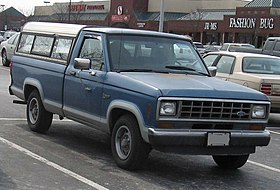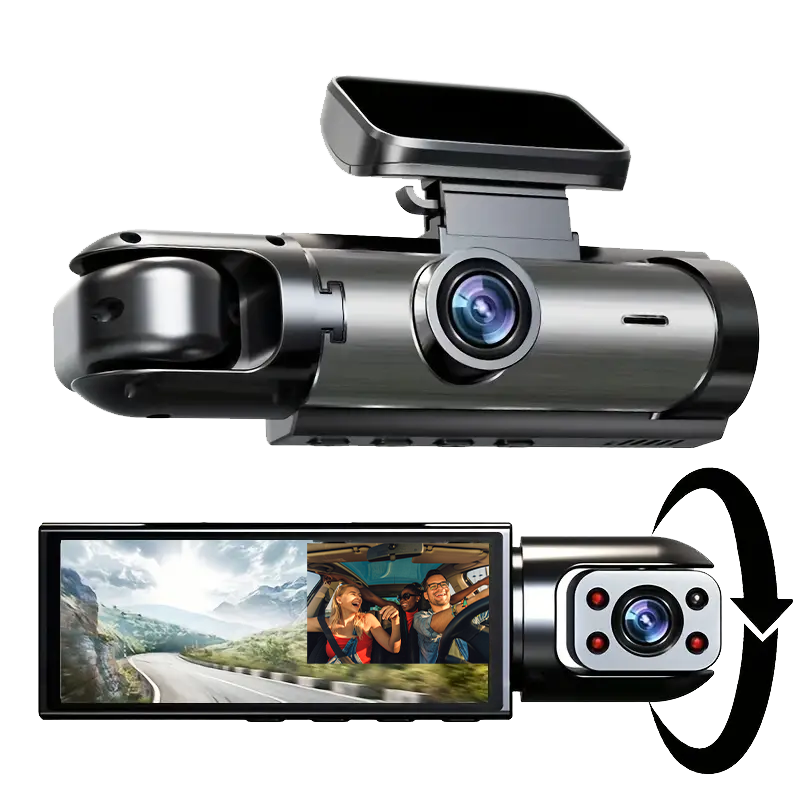
Ford Ranger Pickup Truck First Generation 1983–1992

| Ford Ranger | |
|---|---|
 |
|
| Overview | |
| Manufacturer | Ford |
| Production | 1982–2011 |
| Model years | 1983–2011 |
| Body and chassis | |
| Class | Compact pickup truck |
| Layout | Front-engine, rear- / four-wheel drive |
| Chronology | |
| Predecessor | Ford Courier |
| Successor | Ford Ranger (post-2011) |
The Ford Ranger is a compact pickup truck that was manufactured and marketed by Ford Motor Company from 1983 to 2012 model years for North America; from 1997 to 2011, a version was also manufactured and sold in South America.
Introduced to replace the Ford Courier produced in Japan by Mazda, the Ranger was produced in two distinct generations While introduced a year after the Chevrolet S-10, the Ranger would go on to become the best-selling compact truck in the United States from 1987 to 2004Over its production life, the chassis and underpinnings of the Ranger would be used for various compact Ford trucks, most commonly as sport-utility vehicles. During the 1990s and 2000s, Mazda adopted a badge-engineered version of Ranger, taking on the B-Series nameplate (the reverse of the Ford Courier produced by Mazda).
Over its 29-year production run, Ford produced the Ranger via three different assembly plants in North America. The Ranger was produced at the Louisville Assembly Plant in Louisville, Kentucky from 1982 to 1999; from 1993 to 2004, production also was sourced from Edison Assembly in Edison, New Jersey. For its entire production run, the Ranger was produced at Twin Cities Assembly Plant in St. Paul, Minnesota. The final 2012 Ford Ranger produced on December 16, 2011, also ended 86 years of production at Twin Cities Assembly as well as the production of compact pickups in general in the United States.
Ford has recently announced that they will be manufacturing and selling the Ranger again starting in 2019.
First generation (1983–1992)
| First generation | |
|---|---|
 |
|
| Overview | |
| Production | January 1982 – 1988 |
| Model years | 1983–1988 |
| Assembly | Louisville, Kentucky, United States St. Paul, Minnesota, United States |
| Powertrain | |
| Engine |
Inline-four engines
V6 engines
Diesel engines
|
| Transmission |
Manual transmissions
Automatic transmissions
|
| Dimensions | |
| Wheelbase | 107.9 in (2,741 mm) 113.9 in (2,893 mm) 125 in (3,175.0 mm) |
| Length | Standard bed 1983–1988:175.6 in (4,460 mm) 1989–1992:176.5 in (4,483 mm) Long bed 1983–1988:187.6 in (4,765 mm) 1989–1992:188.5 in (4,788 mm) Supercab 1983–1988:192.7 in (4,895 mm) 1989–1992:193.6 in (4,917 mm) |
| Width | 1983–1988: 66.9 in (1,699 mm) 1989–1992: 66.8 in (1,697 mm) |
1983–1988
Ford began development of the Ranger in 1976, focusing on quality and fuel efficiency. The intent was to build a truck that was as capable as the full-size F-Series, but in a more economical package. The compact Ranger had a similar styling to the full-size Ford F-Series, used a similar architecture, and was offered with a four-wheel drive capability. This ability allowed the Ford Ranger to haul a 4-foot (1.2 m) wide sheet of plywood, which is a common standard for a pickup truck. In the compact Ranger, however, the space between the wheel wells was less than four feet; Ford designed the box with recesses to insert supports across the bed, allowing it to haul a standard sheet of plywood above the wheel wells.
In addition, a key factor driving the development of the Ford compact truck was the 25 percent "Chicken tax" on imported trucks. Although Japanese truck manufacturers had circumvented the tariff by importing vehicles as cab-chassis trucks and installing the truck beds separately, building a truck in North America was a more practical option.
Ford began production of the model year 1983 Ranger on January 18, 1982 at the Louisville Assembly Plant, hitting showrooms in March. Available engines were the 72 hp (54 kW) 2.0 L and 82 hp (61 kW) 2.3 L OHC four-cylinders, a four-cylinder 59 hp (44 kW) 2.2 L Mazda/Perkins diesel, and a 115 hp (86 kW) 2.8 L Cologne V6. In 1985, a Mitsubishi-built 2.3 L turbo-diesel with 86 hp (64 kW) replaced the Mazda diesel engine, and in 1986, the 2.8-liter engine was replaced with a 140 hp (104 kW) 2.9 L Cologne V6. The Super-cab was introduced in 1986, offering an extra 17 inches (432 mm) of storage space behind the front seats, with a pair of jump seats available as an option. Also in 1986, the gauge cluster was modified to allow fitment of a factory tachometer. A lot of the parts of the interior such as the steering wheel, door handles, and the window cranks were similar to those in other Ford vehicles like the Bronco, Escort, and the F-Series.
Mid-year 1986 saw the introduction of the Ranger GT in California only. Available as a standard cab with a short or long bed, it had a 2.9-liter Cologne V6 with either a five-speed Mazda manual transmission or an optional A4LD automatic transmission putting power to a traction-lock differential. Inside, the pickup was equipped with special bucket seats, full instrument cluster, and an optional center console. Front and rear sway bars were installed and 14-inch aluminum wheels completed the package.
Facelift 1989–1992
The truck received a facelift in 1988 for the 1989 model year, which included flush composite headlamps, new front fenders, hood, and grille, along with some upgrades to the frame. Inside, there was a modern new dashboard and steering column.

The new steering column included, on automatic transmission-equipped models, a column-mounted gear shift, and key removal on manual transmission models became a simpler, one-handed operation. Manual-equipped 1983–88 models had the key release button beneath the column on the left-hand side, requiring drivers to use both hands to remove the key.
Rear-wheel antilock brakes were added, and a 21 US gal (79 L; 17 imp gal) fuel tank was now optional on extended-cab models.
Beginning in 1989 (until the end of 1997) the only transmission available on supercab models was the 5-speed Mazda M5OD-R1 manual transmission (while regular cab models were equipped with a manual or automatic transmission during 1989-1997 model years). The 2.0-liter engine was discontinued, and the 2.3 now had a distributor-less ignition system with two spark plugs per cylinder, giving it a 10 hp (7 kW) boost and better fuel economy. The three-speed automatics were dropped, leaving only the A4LD. The new 155 hp (116 kW) 4.0 L Cologne V6 was added to the option list for all models in 1990. The 3.0-liter Vulcan V6 was also offered in the Ranger beginning in model year 1990. The 2.9-liter continued on alongside the 3.0-liter until model year 1992 when it was discontinued.
The Ranger GT was discontinued, although the Ford Truck Public Affairs office did build a prototype for 1990 powered by a 3.0 L SHO V6.
